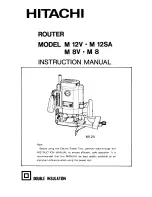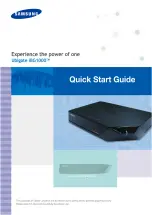
DGS-3700-12/DGS-3700-12G Series Layer 2 Gigabit Ethernet User Manual
86
1. A configuration name defined by an alphanumeric string of up to 32 characters (defined in the
MST
Configuration Identification
window in the Configuration Name
field).
2. A configuration revision number (named here as a Revision Level and found in the
MST Configuration
Identification
window) and;
3. A 4096-element table (defined here as a VID List in the
MST Configuration Identification
window), which
will associate each of the possible 4096 VLANs supported by the Switch for a given instance.
To utilize the MSTP function on the Switch, three steps need to be taken:
1. The Switch must be set to the MSTP setting (found in the
STP Bridge Global Settings
window in the STP
Version field).
2. The correct spanning tree priority for the MSTP instance must be entered (defined here as a Priority in the
STP Instance Settings
window when configuring an MSTI ID
settings).
3. VLANs that will be shared must be added to the MSTP Instance ID (defined here as a
VID List
in the
MST
Configuration
Identification
window when configuring an MSTI ID settings).
802.1w Rapid Spanning Tree
The Switch implements three versions of the Spanning Tree Protocol, the Multiple Spanning Tree Protocol (MSTP) as
defined by the IEEE 802.1s, the Rapid Spanning Tree Protocol (RSTP) as defined by the IEEE 802.1w specification
and a version compatible with the IEEE 802.1D STP. RSTP can operate with legacy equipment implementing IEEE
802.1D. However, the advantages of using RSTP will be lost.
The IEEE 802.1w Rapid Spanning Tree Protocol (RSTP) evolved from the 802.1D STP standard. RSTP was
developed in order to overcome some limitations of STP that impede the function of some recent switching
innovations, in particular, certain Layer 3 functions that are increasingly handled by Ethernet switches. The basic
function and much of the terminology is the same as STP. Most of the settings configured for STP are also used for
RSTP. This section introduces some new Spanning Tree concepts and illustrates the main differences between the
two protocols.
Port Transition States
An essential difference between the three protocols is in the way ports transition to a forwarding state and in the way
this transition relates to the role of the port (forwarding or not forwarding) in the topology. MSTP and RSTP combine
the transition states disabled, blocking and listening used in 802.1D and creates a single state Discarding. In either
case, ports do not forward packets. In the STP port transition states disabled, blocking or listening or in the
RSTP/MSTP port state discarding, there is no functional difference, the port is not active in the network topology.
Table 4-2 below compares how the three protocols differ regarding the port state transition.
All three protocols calculate a stable topology in the same way. Every segment will have a single path to the root
bridge. All bridges listen for BPDU packets. However, BPDU packets are sent more frequently - with every Hello
packet. BPDU packets are sent even if a BPDU packet was not received. Therefore, each link between bridges is
sensitive to the status of the link. Ultimately this difference results in faster detection of failed links, and thus faster
topology adjustment. A drawback of 802.1D is this absence of immediate feedback from adjacent bridges.
802.1s MSTP
802.1w RSTP
802.1D STP
Forwarding
Learning
Disabled
Disabled
Disabled
No
No
Discarding
Discarding
Blocking
No
No
Discarding
Discarding
Listening
No
No
Learning
Learning
Learning
No
Yes
Forwarding
Forwarding
Forwarding
Yes
Yes
Table 4 - 2. Comparing Port States
RSTP is capable of a more rapid transition to a forwarding state - it no longer relies on timer configurations - RSTP compliant
bridges are sensitive to feedback from other RSTP compliant bridge links. Ports do not need to wait for the topology to stabilize
before transitioning to a forwarding state. In order to allow this rapid transition, the protocol introduces two new variables: the
edge port and the point-to-point (P2P) port.
Содержание DGS-3700-12
Страница 1: ...User Manual Product Model DGS 3700 Series Layer 2 Managed Gigabit Ethernet Switch Release 2 00 ...
Страница 145: ...DGS 3700 12 DGS 3700 12G Series Layer 2 Gigabit Ethernet User Manual 143 Click Apply to implement changes made ...
Страница 148: ...DGS 3700 12 DGS 3700 12G Series Layer 2 Gigabit Ethernet User Manual 146 ...
Страница 317: ...DGS 3700 12 DGS 3700 12G Series Layer 2 Gigabit Ethernet User Manual 315 ...
















































